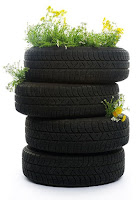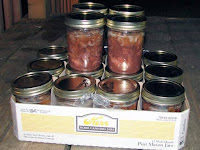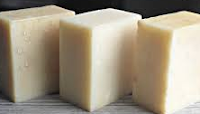This year we are focusing on building up new sections of the garden area. We laid wood chips in a thick layer. Then, we laid down cardboard. On top of it all, we placed straw bales. Hopefully in a season or two, we'll have a foot or more new, rich, composted soil over the hard, compacted red clay and granite rocks in which to grow vegetables in.
Straw bale gardening is another adaptive gardening technique. But for us, I'm not talking a dozen straw bales. I got fifty of them. As I said, our garden needs to provide a year's worth of vegetables for us. Each row around the perimeter of the garden took 10 bales a side in a trapezoid shape. This is all new ground for the garden. It was previously a rough driveway of sorts so the clay is really compressed. Now, with the new driving areas graveled in, we've got a definite borders to the garden besides just a fence.
While planting or transplanting these bales, would be a classic adaptive or handicapable garden, the interior of the garden is the standard row planting. Unlike the previous year where I misplanted some crops in low raised beds that should have been elevated and vice versa, this year I'm actually mapping it out before I plant. I know what I need to plant where.
I'm also not listening to Mel this year. Her idea of walkways between rows and mine are feet apart . Her ideal walkway between tomato plants is 2' when actually with the sprawling growth, tomatoes really need 4' between rows. I just really have difficulty managing to weed and harvest in that narrow of a row spacing. My toy box garden cart or a garden cart won't fit between the rows once the plants reach full maturity.
 We are still growing potatoes in tires.
Old tires are easy to manage. It's upcycling although there is some
concern about toxicity of old tires. We roughly get 50 lbs of potatoes a
year and that is just about right for the two of us to consume. I just
throw another tire on the stack and compost as it grows. I usually stop
mounding tires and compost when I get five tires stacked. That's roughly
5lbs of potatoes for each tire. We usually do two tire towers for 50
lbs or there abouts. To harvest, it's simply removing the tires one by one and pulling
the potatoes out. The soil can be mixed with new compost and it's
recharged for the next plants. The straw we put in the noncentral parts of the tire also decompose over the growing season. The reason we do this is water tends to pool inside of this part. It serves to provide a moist not soggy growing area.
We are still growing potatoes in tires.
Old tires are easy to manage. It's upcycling although there is some
concern about toxicity of old tires. We roughly get 50 lbs of potatoes a
year and that is just about right for the two of us to consume. I just
throw another tire on the stack and compost as it grows. I usually stop
mounding tires and compost when I get five tires stacked. That's roughly
5lbs of potatoes for each tire. We usually do two tire towers for 50
lbs or there abouts. To harvest, it's simply removing the tires one by one and pulling
the potatoes out. The soil can be mixed with new compost and it's
recharged for the next plants. The straw we put in the noncentral parts of the tire also decompose over the growing season. The reason we do this is water tends to pool inside of this part. It serves to provide a moist not soggy growing area.After the initial potato harvest, I'll stack and fill the tires two high for sweet potatoes or onions. Some of the tires I'll leave as singles and plant spinach or other greens in them. I do like my gutter planters (another adaptive gardening technique) for lettuces though. I can pick micro greens to my heart's content without stooping. Gutter planting works best on quick harvesting like salad greens. They aren't deep enough for standard crops. They also tend to dry out quickly so close and careful monitoring is essential. I've watched videos on using this technique for strawberries, but when I attempted it I found the soil depth too shallow for an abundant harvest.
 If
you are only raising two or three tomato plants a raised bed is fine,
but this year we'll be plant a minimum of 25 plants between Roma paste
tomatoes and Cherokee blacks. The same goes for other vegetables too.
For seedling or seeds planting, I carry two sticks. One is 6" long and
one is 3' long. Can you guess why? The 6" stick is for elevated raised
bed planting. Our beds are only 3 1/2' wide. It's an easy reach to the
center of the beds. The 3' stick is for ground level planting. It's also
a substitute cane if I need it. I use a lot of different things in the
garden that can substitute for my cane; a rake or hoe works wonderfully.
I can get pretty creative when it comes to my mobility issues and doing
what I want/need to do.
If
you are only raising two or three tomato plants a raised bed is fine,
but this year we'll be plant a minimum of 25 plants between Roma paste
tomatoes and Cherokee blacks. The same goes for other vegetables too.
For seedling or seeds planting, I carry two sticks. One is 6" long and
one is 3' long. Can you guess why? The 6" stick is for elevated raised
bed planting. Our beds are only 3 1/2' wide. It's an easy reach to the
center of the beds. The 3' stick is for ground level planting. It's also
a substitute cane if I need it. I use a lot of different things in the
garden that can substitute for my cane; a rake or hoe works wonderfully.
I can get pretty creative when it comes to my mobility issues and doing
what I want/need to do.I say that living post stroke has been an adventure. In a way it has been a great blessing. A blessing?! I hear y'all now wondering how anyone would consider surviving a stroke is a blessing. "Jo, you've stepped off the ledge and are free falling into the crazy zone!" My response is still, it's a blessing. Hear me out. I jokingly say that God permitted my strokes to happen to me to teach me patience and it's working.
- I have met many wonderful and supportive people since my stroke. Ones I may not have met otherwise. I inspire regular folks to break free of their comfort zones and try something new.
- In spite of all I lost in abilities, I've found new and creative avenues to enjoy that I may not have tried if it weren't for my strokes.
- I'm thinking more outside the box to achieve what I want out of life. Admittedly, I've always thought outside the box, but now it's extreme and I love it.
- Through the frustrations in attempting to live my life post stroke, I've developed a more patient attitude. See, God, it's working.
- Through my pain, I have a deeper compassion and empathy for others than I had before. I can relate more on a one by one basis.
- Through my limited ability, doors or windows open that were closed shut before.
Sure, adaptive gardening techniques are for small time gardeners. But sometimes, the end results can be greater than you first thought. I'm still trying to get back to the production levels here as I had on my old property. It will happen. It just takes time. I'm patient. Hear that God! I'm being patient. If you are physically impaired, it's the only way to get something good out of a bad situation. Gardening adaptively, let's you produce your own food. Maybe not most of it like we do, but even if you produce one tomato, it's gonna be the best tasting tomato you have ever eaten. Plus, you know where it came from, how it was grown, and you tried something new. So what are you waiting for? Let's get down and dirty.
Y'all have a blessed day!
























